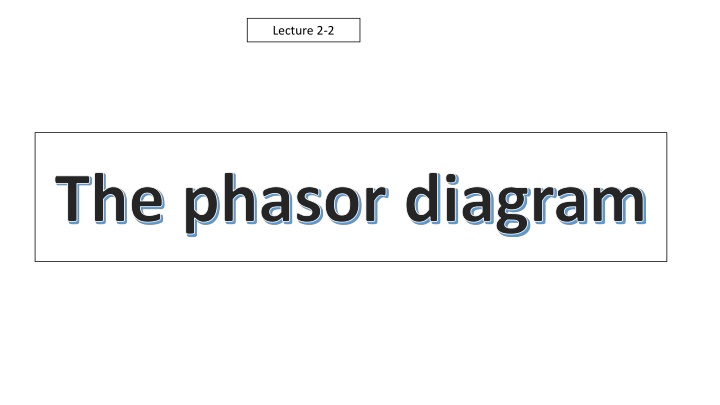
Understanding Phasor Diagrams and Sinusoidal Waveforms in Electrical Engineering
Explore the significance of sinusoidal waveforms, equations representing voltage/current, and the concept of angular frequency. Learn how to add sinusoidal voltages and understand radian angles in rotating bodies for electrical applications.
Download Presentation

Please find below an Image/Link to download the presentation.
The content on the website is provided AS IS for your information and personal use only. It may not be sold, licensed, or shared on other websites without obtaining consent from the author. If you encounter any issues during the download, it is possible that the publisher has removed the file from their server.
You are allowed to download the files provided on this website for personal or commercial use, subject to the condition that they are used lawfully. All files are the property of their respective owners.
The content on the website is provided AS IS for your information and personal use only. It may not be sold, licensed, or shared on other websites without obtaining consent from the author.
E N D
Presentation Transcript
Lecture 2-2 The phasor diagram
Why the generators supplying the electric current to the consumers choose the sinusoidal waveform? What is the meaning of the equation representing the sinusoidal voltage and current? ? ? = ??????? ?? ? ? = ??????? ?? What is ? ? And what is the need of this factor?
How can you add two sinusoidal voltages ??and ??? Is it easy to do that?
vT v1 ?2 v2 The case at ? = 0 This means that you can easily add two sinusoidal varying scalar quantities by using vector summation method!!!! c a b The case at ? = ?2
What is the radian angle? In order to answer this question, we have to know the meaning of the factor ? . The need arises for this symbol when we need to determine the linear speed of different points ?1,?2, ,?? located at radii ?1,?2, ,??respectively on a non- uniform body {rotating at ( ? ) revolutions per seconds (rps) as shown in figure (1) below. Pi, ri Non uniform body rotating around certain center of rotation. p2, r2 Direction of rotation p1, r1 ? Fig. (1) Center of rotation
Then ?1= 2??1? (ms-1), and?2= 2??2? ., ??= 2???? Where ?? represents the linear speed of the point on the rotating body located at radius ?? from the center of rotation. From the above equations it is clear that the quantity (2??) is common for any ?? mentioned above. Then, in order to simplify the calculations, it is easier to calculate this quantity (2??) once, and substitute its value in the above equations as a factor called (Omega) ? {which is a symbol of a letter from the Greek Alphabet}, and it is called "the angular frequency". Then, in general ??= ??? Then, the meaning of the factor ? is clear now!!!!!!!!!!! To answer the above question (What is the radian angle?), we have to refer to the above figure also.
It is clear that, when the body rotates certain angle ? at certain time (?1), all the points on that body rotate at the same angle in spite of their different radii as shown in figure (1). Since: ??? ????? ?? ????? ?1 ?1 =??? ????? ?? ????? ?? =??? ????? ?? ????? ?2 ?2 ?? Then ?1 ?1 ?1 =?2 ?1 =?? ?1 = constant ?2 ?? It is clear now that the ratio of the arc length in front of the angle ? to the corresponding radius for any point (??) is a constant quantity. Now, if the factor ? is analyzed as follows: ? = 2?? = 2?1 ?
1 4? , and this value Where T is the time of one rotation, then if for example ? = is substituted in the factor ?? results in that: ?? = 2?1 ? 1 4? =? 2 It is well known that at 1 4? the rotating body moves quarter circle exactly which corresponds to 90 !!!!!!!!!!! This constant ?? can be considered as the new representation of the angle ? instead of the ordinary representation by degrees. Now, it is clear that when the body rotates a quarter cycle, then the elapsed time ? is ? 4 {when ? is the time elapsed by one cycle and (? = 1 ? the constant ?? in this case equal to 2???? ? 4 )}, hence, ??
2???? ? 4 ?? Or ?? = ?? = 2? 1 ?? ? 2 and this value corresponds to 90 . 4= 4= Then ? 2= 90 And in the same way ? = 180 And 3? 4= 270 And 2? = 360
This new definition of angle measurement unit ?? is called (Radian). Since (? = 3.141592654), and since ? corresponds to 180 then 180=3.141592654 ? 1 = = 0.017453292 ?????? 180 And 1 ?????? =180 180 3.141592654= 57.29577951 = ? Why we need the radian angle ?? representation? The radian angle representation ?? is the only mathematical formula seems to be suitable for representing a sinusoidal varying quantity as a function of time (such as voltage or current), in that it can describe their instantaneous magnitude at any time in a simple way. Then the sinusoidal waveforms of the current and voltage can be represented as a function of ? in radians by using time as a variable as shown: ? ? = ????sin ?? ? ? = ????sin ??
? (in radians per second), is larger than Angular frequency frequency (in cycles per second, also called Hz), by a factor of 2? . This figure uses the symbol , rather than ? to denote frequency.






















